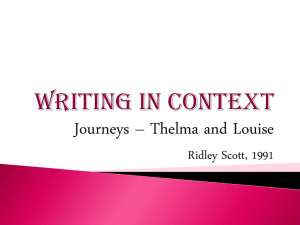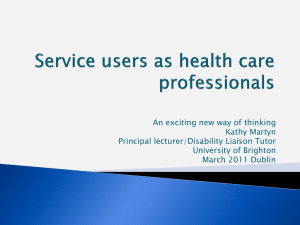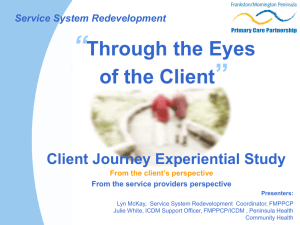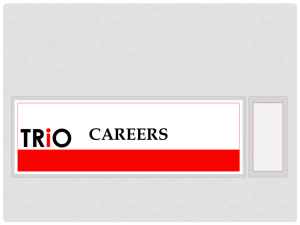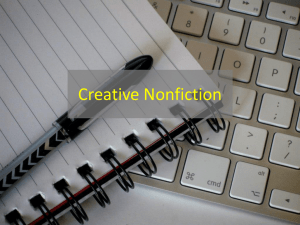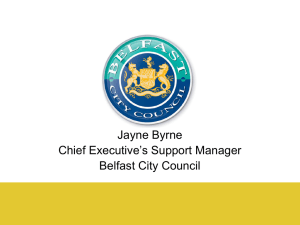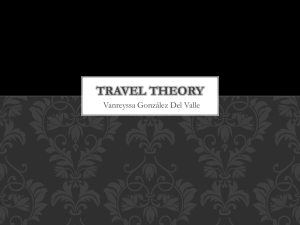AREA of study: Journeys
advertisement
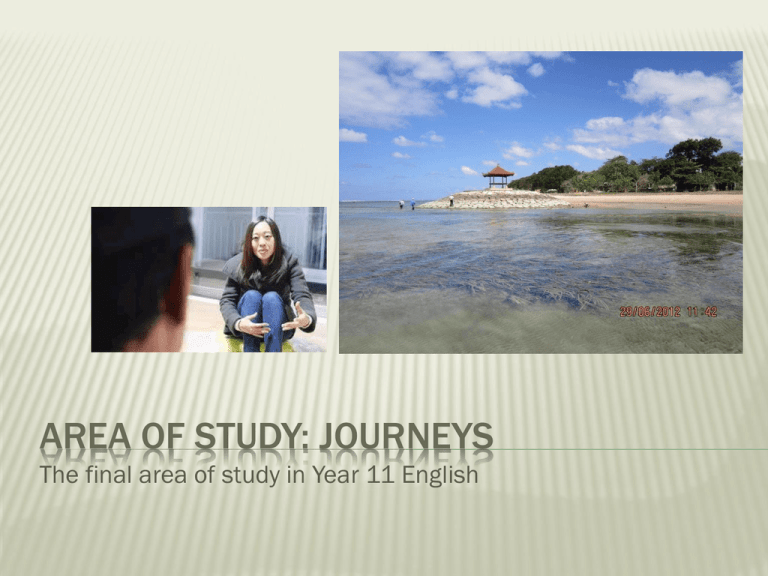
AREA OF STUDY: JOURNEYS The final area of study in Year 11 English Journeys How many kinds of journeys can you think of ? Tell the person sitting next to you (in Bahassa Inggris) Types of Journeys we will discuss: - - Physical Journeys Journeys to a foreign country, or foreign culture Journeys of survival Journeys towards freedom Emotional and spiritual journeys Journeys taken by choice and journeys that we did not ask for. Journeys Texts we will read: The Road Not Taken – A poem by Robert Frost North Korean Man Learns to Trust the Stranger Who Saved Him – Non-fiction: a news article published in the Los Angeles Times. Journey to Freedom– A non-fiction biographical narrative by Hai-Van Nguyen Cast Away – A 2000 film directed by Robert Zemeckis and starring Tom Hanks. Journeys Questions we will ask: - What sets a journey in motion? - How is a journey told through film? - How is a journey told through non-fiction writing? - How do emotional and spiritual journeys coincide with physical journeys? - What kinds of journeys do we undertake in life? (Do the journeys choose us, or do we choose the journeys? - How do journeys relate to choices? Journeys What we will learn: - How to analyze journeys through the features of film, journalism and biographical narrative. - How to structure and write an analysis essay. - How to write and respond to an in-class essay (this will be prep for your final exam covering all the areas of study). - How writers use narrative techniques to create a journey for the reader. - What we can reflect on: - Our own journeys so far – geographically, emotionally, intellectually. - Your journey of faith as a follower of Jesus - The journey of Saint Paul; his letter to the Philippians Journeys Our Assessments: 1. A short, in-class, essay that will compare the two non-fiction texts and discuss the differences between a journalism story and a biographical account. 2. A type-written, detailed analysis essay that discusses film techniques and how the idea of Journeys is conveyed in the film Cast Away For due dates, check your COURSE OUTLINE ! Journeys How we will get there… 1.By reading, reading out loud, and Reading a lot. 2. By practicing our writing in an English notebook. This notebook will Contain both a section for your Warm-ups and a section for Writing that will contain your class work. 3. By learning to think in English with an English speaking environment. 4. By writing our final essay in stages: brainstorm, thesis, outline, opening paragraph, body paragraphs, revision. Journeys These seven weeks are prep for year 12, the HSC Exam and University. 1. When you are in class, be on time, and be focused. 2. Read and speak in English – no Bahassa Indoesia. 3. Be aware of due dates; they are in your course outline. Even if I do not remind you in class, a due date is still a due date. 4. Do your own work; don’t even think about copying. 5. Your writing assignments and class work in the WRITING section will count for credit, as will your WARM-UPS. Journeys - What sets a journey in motion? STASIS – a situation that has settled or reached equilibrium. A stasis will not change. INTRUSION – An event that, INTRUDES, or breaks a stasis. An intrusion marks the beginning of a story, a conflict, or a journey. Stasis – An English teacher goes on a relaxing vacation to Bali Intrusion? - English teacher realizing he is running out of money AND the hotel insists that he hasn’t paid. Journey Groups #1 - Brainstorming * Confer with your groups and answer the following questions in your WRITING section of the notebook. Please include the date. Describe a plausible INTRUSION for the following: - A fast-talking lawyer who lies to get ahead puts his career over his family… - A dutiful 11th Grader walks into his or her English class for a new semester at IPEKA… - An old Balinese fisherman with a wife and a family sets out on his small, wooden boat to fish … - On a humid evening, a Jakarta taxi driver pulls over at Puri Mall to pick up a passenger… Journeys – What begins a Journey STEP 2 - Answer the following questions: - - How do YOU define a journey? What needs to happen for a character for them to be on a journey? Take one of the situations that you responded to and expand the INTRUSTION into a journey. (This should be a short paragraph) Come up with a name for your group! Journeys – What begins a journey How do we define a journey ? “A journey is best measured in friends rather than miles,” – Tim Cahill “The journey of a thousand miles begins with a single step.” – Lao Tzu “A journey is a person in itself; no two are alike. And all plans, safeguards, policing, and coercion are fruitless. We find that after years of struggle that we do not take a trip; a trip takes us.” – John Steinbeck Journeys Groups–The Road Not Taken (Robert Frost) The Road Not Taken – Published in Selected Poems in 1973. - One of the best known of the author’s poems Robert Frost, Famous 20th Century American Poet Journeys Groups–The Road Not Taken Diverge To go or extend in different directions from a common point. Undergrowth Low-growing plants and shrubs beneath the trees of a forest. Wanted Wear To ‘want’ something can also mean to ‘lack’ or ‘not have’ it. ‘Wear’ is a noun meaning a state of being worn out. Trodden Past tense form of ‘tread,’ meaning to ‘walk on.’ Journeys The Road Not Taken STEP 2 – Discuss the following Questions with your groups and then answer these questions In your WRITING section: 1. What kind of decision is described in The Road Not Taken? 2. What words, images and rhyme patterns convey the author’s dilemma? 3. On a deeper level, what does this poem say about the consequences of choices? Journeys The Road Not Taken A Metaphor – a physical object that stands for an abstract idea. A metaphor is specific; it usually embodies one or more characteristics of the idea it represents. In the Road Not Taken, the path diverging in the woods is a metaphor for an important decision in the author’s life. In stanza 1, the author discovers two paths in the road, (a decision he must make). In stanza 2, the author compares the two roads, (weighing the decision) and realizes in stanza 3 that the consequences of his decision will be irreversible. From reading stanza 4, what was the author’s decision and what does he feel about it? Journeys – In Class Writing Practice Robert Frost’s poem The Road Not Taken describes a journey in which consequences result from a simple choice. Describe a significant choice that you have made in life, or a choice that you will have to make in the near future. What kind of journey will this choice present? What consequences? Journeys The Road Not Taken HW (Typed & printed out) Brainstorming and Evidence Gathering Brainstorm three answers to the following question: What is one idea about Journeys that you found in the poem the The Road Not Taken? What techniques does the author use to present this idea? - WRITE out each answer in complete sentences and follow it up with some bullet points that include QUOTED evidence from the Essay. Journeys – Text #1 Journalism Article HW: Read through the text North Korean Man Learns to Trust the Stranger who Saved Him In your WRITING section, list THREE DETAILS from the story that you find descriptive (A quotation, an image, a flashback, or even the sub-heading). Briefly explain how each detail contributes to impact of the story Journeys – Text #1 Journalism Article Background: North Korea -Democratic People’s Rep. of North Korea. (DPKR) -Capital: Pyongyang -Population: Approx. 24 million -Upper half of the Korean Peninsula; separated from South Korea by a Demilitarized Zone (DMZ); technically still at war - Single-party system with a personality cult build around the late leader Kim Jong-Il (recently passed away). - Centrally planned (Government owned) Economy - Hermit Kingdom (no trade and limited relations with outside world and intl’ community. ) Journeys – Text #1 Journalism Article - - Those who try and defect from North Korea through China are punished severely or killed. Political prisoners are sent to forced labor camps. (Visible by satellite) Gov’t mismanagement has led to mass starvation in recent years. Journeys – Text #1 Journalism Article The Heroine! - Korean-American Fiction author Krys Lee. - Author of Drifting House, a collection of stories about Korean-Americans and those struggling to survive in North Korea. -Grew up in California and Washington State, now lives in Seoul. Her journey included emotional and family struggles as well. - Made risky trips to China to help Kim Yong-chul, a North Korean defector. Journeys Journalism – News and Feature Articles -Concise wording (Articles usually 800–1000 words -Lead paragraph to hook readers -Objective (author does not state opinions.) -Brief, factual writing with lots of specific details -Strong description (people, places, metaphors) -Fact-based, research, uses quotations -Expositor y information (WHO, WHAT, WHEN, WHERE, WHY & HOW) -Timeline / retelling the events in the story (flashbacks) -Emphasis on characters and events Journeys – Text #1 Journalism Article Story Angle: The significance of the story – the purpose. Expressed in the way the writer tells the story and uses details (character, description, events). Not always stated, like a conclusion. -Answers the question: Why is is this story important? Journeys – Text #1 Journalism Article The purpose of a News or Features Story -A news or features story is written to inform the reader about an Interesting or unique event and Explore that event through details. -A journalism story offers an approach (the story angle), but DOES NOT state CONCLUSIONS for the reader. A story invites the reader to examine the details and make up his or her own mind. Journeys – Text #1 Journalism Article Journey Groups: Narration of Events Task ONE: Draw a timeline of the events in the story as they happened in REAL LIFE Task TWO: Draw a parallel timeline that shows the order of events in the STORY. Task THREE: For every event on the story timeline, cite one phrase, fact or quote that the writer uses to describe the event to the reader. Journeys – Text #1 Journalism Article WRITING SECTION – Short Answers In your own words, describe Kim’s journey to freedom (how is his journey BOTH physical and emotional?). - Why is the friendship that develops between Kim and Lee important to the story? Find one quote or detail from the story that shows this importance Journeys Features of PERSONAL NARRATIVE HW: Written paragraph, half a page, TYPED In your own words, explain the purpose of a Journalism article. Use TWO examples from the article North Korean Defector in your explanation. How do they contribute to the purpose of the article? Journeys An Opening Paragraph Even though journalism articles now compete with blogs, tweets and TV news for the reader’s attention, they still offer something unique: skillful, excellent writing for educated readers. *The purpose of a news or a feature article—for example, the L.A. Times article North Korea Defector Learns to Trust the Stranger Who Saved Him—is to the present the reader with the details and significance of a story. An article is objective, meaning the author uses strong description, facts and quotations to tell the story, but refrains from sharing his or her opinion.* However, wellwritten articles contain a story angle, or an emphasis on what is most significant in the story. Journeys Opening Paragraph Pattern -Lead sentence -Context (if introducing a text) -Thesis statement - Summarizing / concluding Journeys Opening Paragraph Pattern Going from a brainstorm to an opening paragraph Let’s say your outline is this: Body Paragraph 1 – Kim’s Physical Journey AND Use of Strong Description to show physical journey 1. Find an example of strong description that would be good evidence for paragraph 1 2. Explain your evidence – how does it illustrate the physical journey? Journeys –Journey to Freedom “The journey is part of the experience -- an expression of the seriousness of one's intent. One doesn't take the First Class train to Mecca.” “No man ever steps in the same river twice, for it's not the same river and he's not the same man.” - Heraclitus Journeys –Journey to Freedom - Personal Narrative by Hai-Van Nguyen. Also called a memoir piece. -Her piece Journey to Freedom won the major prize in the Australia IS Refugees Competition. Also published in Australian newspaper The Age in 2002. -Recounts the story of her family as they journeyed from Vietnam to Malaysia on a crowded boat full of other refugees (1981). - Her piece also discusses the challenge of adapting to a new culture, and how Western cultures (like Australia) can be blind or insensitive to those fleeing from atrocities. Journeys –Journey to Freedom Vietnamese Refugees – ‘Boat People’ - After the fall of Saigon, which ended U.S. involvement in Vietnam, many Vietnamese (several hundred thousand) were imprisoned, executed or sent to labor in New Economic Zones. -Nearly a million Vietnamese fled from Vietnam to mostly Western countries. - Around 137,000 made it to Australia by leaving for Malaysia in crowded boats. This was a dangerous journey. Journeys – Text #2 Journey to Freedom Features of PERSONAL NARRATIVE -Biographical – the author is writing about him or herself. It is the author’s story! -Detailed Description – the author uses vivid description and fiction techniques to illustrate the story. MORE description than a features article. -Characters - Setting -Memoir (recount) – writing that describes the author’s memories or experiences. -Subjective – The author INCLUDES their opinions, emotions and conclusions about the story. Journeys –Journey to Freedom WRITING SECTION 1. Find two quotations from the story that show the author presenting her opinion. What effect does she create by including her emotions/opinions? 2. What point does the author make about using numbers to describe atrocities? What narrative technique does she use to make this point? Finish reading Journey to Freedom Journeys –Journey to Freedom Reading Questions (Page 2) How do Hai’s parents deceive her as travel on the boat to Malaysia? Why do they do this? What are some of the potential dangers for the refugees in the boat? What happens when the tiny boat passes by a huge cargo ship? Journeys –Journey to Freedom Friday Free write -FIRST: Discuss with a neighbor. How is learning a new language a journey? Can it be a journey on two different levels (for example – emotional and spiritual?) Explain with examples from your own experience. Journeys –Journey to Freedom Writing the dreaded BODY PARAGRAPH… -Your goal for the essay: ANALYZING the text(s). Showing your understanding of the features in a text and what effect they have. - Analyzing SPECIFIC DETAILS (Quote or paraphrase them). Explain their effect. -PLOT SUMMARY is not enough -Going OFF TOPIC is not acceptable. Journeys –BODY PARAGRAPHS Whatever you do… DON’T PANIC… Journeys –Break for a Burger! TOP BUN Topic Sentence (What you are showing in THIS paragraph?) LETTUCE/TOMATO Context for Details CHEESE Quotes and Details (‘Cited’ or Paraphrased) BEEF Analysis (Explain details.) BOTTOM BUN Conclude OR Give Context for NEW EVIDENCE Journeys –Break for a Burger! BUILD YOUR OWN PARAGRAPH 1. Follow the example in Mr. Curtis’ Body Paragraph and write a NEW PARAGRAPH about how the author uses descriptive detail in Journey to Freedom. 2. Use Quoted evidence and connect it to Nguyen’s purpose: describing the intensity of her journey for the reader. Journeys –Break for a Burger! BUILD YOUR OWN PARAGRAPH HW: In your WRITING SECTION -Take five or six of the Evidence, details or quotations that you found in Journey to Freedom and STRUCTURE THEM into body paragraphs. -You don’t need to write out the body paragraphs, but think of where they would fit -FOR EXAMPLE – ONE PARAGRAPH about SETTING, ANOTHER PARAGRAPH about the author’s opinion on the perception of refugees. Journeys –Journey to Freedom Reading Questions (Fifteen Min.) (Page 3) What sensory details does the author use to Describe the boat on the top of page 3? (Write some down for your notes). How does the author describe the refugee camp in Malaysia? How do the conditions of the camp compare to the boat? The narrator jumps forward in time to her parent’s kitchen in Australia. What connection does she make between her father and an experience he had at camp? Journeys –Journey to Freedom Reading Questions (Fifteen Min.) (Last Page) What enables Hai’s family to emigrate to Australia? What does she describe happening to those who are denied entry? How does Hai describe the obstacles of adjusting to life in Australia? Summarize the thoughts and opinions presented in the last paragraph of the story. Instead of focusing on numbers, what should society focus on in order to understand refugees? Journeys –Journey to Freedom Reading Questions (Fifteen Min.) (Last Page) What enables Hai’s family to enter Australia? Describe the process What does she describe happening to those who are denied entry? How does Hai describe the adjustment to life in Australia? (What descriptive technique does she use?) Summarize the thoughts and opinions presented in the last paragraph of the story. Instead of focusing on numbers, what should society focus on in order to understand refugees? Journeys –Journey to Freedom Reading Questions (Fifteen Min.) (Last Page) What enables Hai’s family to enter Australia? What happens to those who are denied entry? How descriptive techniques does Van-Nguyen use to describe the refugee experience? -To describe the adjustment to life in Australia? Summarize the thoughts and opinions presented in the last paragraph of the story. Instead of focusing on numbers, what should society focus on to understand refugees? Journeys –Journey to Freedom Group Project – Body Paragraphs PROMPT: How does Hai Van-Nguyen portray different settings in her personal narrative Journey to Freedom? Describe the techniques that she uses. GROUP PROJECT: Design and write an OPENING PARAGRAPH and one BODY PARAGRAPH. - The opening paragraph must include a SUMMARY of the story and a THESIS statement - The body paragraph must include TWO QUOTATIONS and ANALYSIS of those quotations. Journeys –Journey to Freedom Sample essay prompt A journalism article is very different from a personal narrative, but both bring a journey to life through powerful detail. Using examples from both texts, explain the differences in journalism and personal narrative. How do both use detail to impact the reader? Journeys –Journey to Freedom Thesis: While personal narrative uses details plus the author’s experience and opinions to impact the reader emotionally, a journalism story uses facts and details to give a more objective view of a journey. Body paragraph 1 – Journalism / North Korean Man -Quotations from characters showing relationship between Kim and Lee / NO OPINION from AUTHOR -Strong description of setting ‘Swill from garbage cans’ Body paragraph 2 – Personal narrative / Journey to freedom -Author’s experience described through details / horrors of boat, of Malaysian camp -Author’s opinion and use of numbers – respect refugees Journeys –Cast Away! Introducing….. WILSON THE VOLLEYBALL!! Journeys –Cast Away Cast Away, not ‘Castaway’ -Released in 2000 -Directed by Robert Zemeckis (top right) -Screenplay by William Broyles Jr. -Stars Tom Hanks (right) as Chuck Noland, a FedEx executive who is shipwrecked and stranded by himself on a desert island. -The film portrays an internal and external journey through showing Chuck’s struggle to survive. -The film camera techniques and action, but little dialogue. Journeys –Cast Away Taking Notes on Cast Away • I would recommend a NEW SECTION of your notes. You will want to jot quick down things you notice about camera techniques, plot, and character development. •Don’t write everything down. •Pay close attention to HOW CHUCK DEVELOPS as a character. Journeys –Cast Away WRITING SECTION 1) Describe the stasis of the story at the beginning of Cast Away. 2) Describe the intrusion. (Hint: what sets Chuck’s journey in motion?) Journeys –Cast Away Final Hints for In-Class Essay - Be sure to talk about the journey (emotional or physical) that is presented in each story. Both stories are ALL ABOUT a journey of survival. - Subjectivity / Objectivity & Story - Read the prompt carefully - Make an OUTLINE before you go for it. - Keep an eye on the clock and pace yourself. Journeys –Cast Away ACT II – The Island Look for examples of each of the following as you watch Cast Away. - Low-angle / high-angle camera shots - Character moments (internal journey - moments that tell us what Chuck is feeling or thinking) - Events that show Chuck’s DEFEATS or VICTORIES as he tries to survive in his new environment (physical journey) - Settings (The island, the beach, the cave). - Action shots and advanced camera shots (Underwater, tracking shots, close-ups) - Humorous moments Journeys –Cast Away Over the Break – Writing Section 1) Make a list of the major events in Chuck’s journey (up until where we have watched in class) and how they are conveyed. (i.e. camera techniques, dialogue, visual humor, etc…) 2) What have you learned in class that you didn’t know before? What do you think about the ‘journey’ of this class so far? Journeys –Cast Away ESSAY Results – 20 Possible 17* highest score awarded 13 – 16 Above Average (Well-developed) 9 – 12 Average (Solid) 5–8 Below Average (or off-topic, failed to answer the question and discuss text features.) Journeys –Cast Away Essays in the 14, 15 and 16 range tended to: - Identify the purpose or characteristics of journalism and personal narrative and then give examples of those characteristics. - Give some summary without simply retelling the whole story. - Use good examples from texts (for example, expository info OR sensory detail, and opinion). - Analyze quotations – explain how they show expository info, or detail that appeals to the senses. Journeys –Cast Away Second Look - Essay Prompt Using both texts we have read, explain how a journey is portrayed in both a journalism article and a personal narrative. Analyze one textual feature that is important to the article and one that is important to the personal narrative. How does feature illustrate the journey in the text? Journeys –Cast Away Quiz! -In complete sentences, using your knowledge of Cast Away, and of film techniques, explain FIVE terms of your choosing. LOW–ANGLE SHOT MID-LEVEL SHOT CROSS CUTTING BIRD’S EYE SHOT LONG SHOT DISSOLVE ESTABLISHING SHOT SETTING CLOSE-UP SHOT Journeys –Prep for Film Analysis Essay HW for Monday – Essay Outline -On one page (typed), come up with a thesis statement that you could use to write your Film Analysis Essay. Remember, you are discussing one idea about journeys or survival that is portrayed through the director's use of film techniques and story. * You will also create an outline of at least three body paragraphs that you could tangibly write for your essay. Your outline should include details of film techniques, events, dialogue and other elements that can show the idea from your thesis statement. Journeys –Prep for Film Analysis Essay Take out your outline! Peer Editing Instructions: -Is there a complete THESIS statement? -Does it mention the text? -Does it suggest a complete thought about journeys or survival? -Does it describe which film techniques convey this idea? -Is there summary of the film? OUTLINE: -Is the outline divided into body paragraphs, (if not, how could it be organized) -Does it include specific film techniques? -Does the paragraphs/details show the idea in the thesis? Journeys –Prep for Film Analysis Essay THIS WEEK – writing section - Free write Reflect on one aspect of Chuck’s emotional journey in Cast Away, (the stasis and intrusion, survival, cross roads at the end, etc…). Connect this aspect of Chuck’s journey to something you have experienced or learned about in your own journey so far. Journeys –Prep for Film Analysis Essay Writing analysis – FOLLOW BURGER MODEL *Summarize specific Details / Then Analyze them! In a horrifying and vivid action sequence, Chuck’s plane to Malaysia falls into a dive from the sky and crashes into the ocean. As the plane screams downward, the camera shakes and buckles to show the ferocity of the dive. The sequence uses close up shots of Chuck scrambling for the watch with Kelly’s picture and of a co-pilot whose head is split open to show the violence and terror of the crash. This superb action sequence conveys the sheer power of the accident and shows that the plane crash is a lifethreatening intrusion to Chuck’s life. Journeys –Prep for Film Analysis Essay Writing analysis – FOLLOW BURGER MODEL *Write your own sequence of analysis: Summary / Describe the details / Analyze and connect them to IDEA SEQUENCES YOU COULD USE: - Chuck making fire - Chuck and Kelly saying goodbye in the car before the plane ride. - Chuck trying to paddle out to the ship and getting tossed by the wave.

